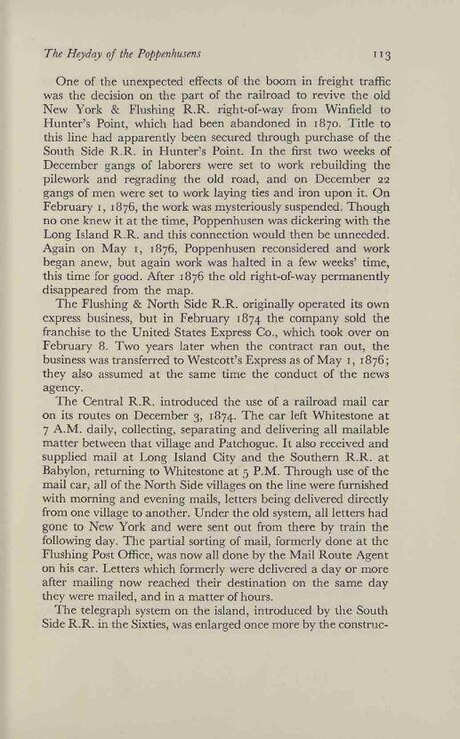One of the unexpected effects of the boom in freight traffic was the decision on the part of the railroad to revive the old New York & Flushing R.R. right-of-way from Winfield to Hunter's Point, which had been abandoned in 1870. Title to this line had apparently been secured through purchase of the South Side R.R. in Hunter's Point. In the first two weeks of December gangs of laborers were set to work rebuilding the pilework and regrading the old road, and on December 22 gangs of men were set to work laying ties and iron upon it. On February 1, 1876, the work was mysteriously suspended. Though no one knew it at the time, Poppenhusen was dickering with the Long Island R.R. and this connection would then be unneeded. Again on May 1, 1876, Poppenhusen reconsidered and work began anew, but again work was halted in a few weeks' time, this time for good. After 1876 the old right-of-way permanently disappeared from the map.
The Flushing & North Side R.R. originally operated its own express business, but in February 1874 the company sold the franchise to the United- States Express Co., which took over on February 8. Two years later when the contract ran out, the business was transferred to Westcott's Express as of May 1, 1876; they also assumed at the same time the conduct of the news agency.
The Central R.R. introduced the use of a railroad mail car on its routes on December 3, 1874. The car left Whitestone at 7 A.M. daily, collecting, separating and delivering all mailable matter between that village and Patchogue. It also received and supplied mail at Long Island City and the Southern R.R. at Babylon, returning to Whitestone at 5 P.M. Through use of the mail car, all of the North Side villages on the line were furnished with morning and evening mails, letters being delivered directly from one village to another. Under the old system, all letters had gone to New York and were sent out from there by train the following day. The partial sorting of mail, formerly done at the Flushing Post Office, was now all done by the Mail Route Agent on his car. Letters which formerly were delivered a day or more after mailing now reached their destination on the same day they were mailed, and in a matter of hours.
The telegraph system on the island, introduced by the South Side R.R. in the Sixties, was enlarged once more by the construc-
